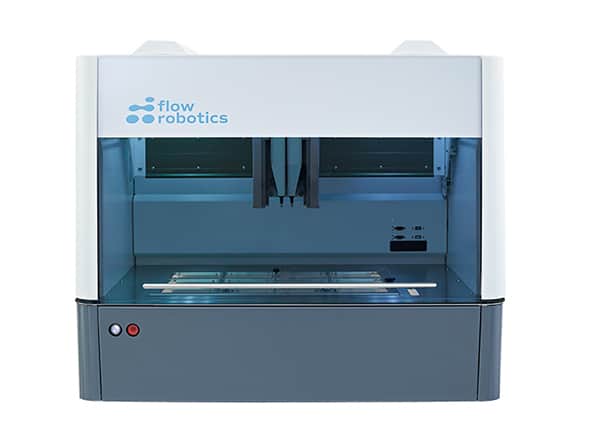Perfecting development of anti-cancer and anti-inflammatory therapeutics
At Numab Therapeutics they are complementing their workflow for developing anti-inflammatory and anti-cancer therapeutics with flowbot® ONE as their dedicated pipetting partner.
More specifically, they have implemented protein solubility and chemical unfolding assays on a 384-well plate format for high throughput screening. Furthermore, the aliquotation of protein samples for internal distribution to other groups for functional and biophysical assessment in 20 µL aliquots is performed by the flowbot ONE.
“The high-throughput assays enable us to rapidly and accurately determine the biophysical characteristics of large panels of scFv binders to select the most compatible building blocks for our multispecific antibodies,” says Marc Thomas, Research Associate at Numab Therapeutics, and the primary user of their flowbot ONE. “This will greatly increase our screening space and optimize our efficiency early in the discovery process.”
ROI and Reproducibility: Getting more for less
“With the flowbot ONE, we get an excellent price/performance aspect. It has comparable key capabilities to those offered by other models but at a fraction of the cost,” Marc recalls as the main factors for the purchase of the flowbot ONE.
During the early assessment of their scFv binders, it is critical to get fast, accurate and highly reproducible results with low material consumption. The use of flowbot® ONE allows Numab Therapeutics to obtain several biophysical parameters within a week. According to Marc Thomas, performing this by hand would be very time consuming. Furthermore, performing this task in person would likely not be possible without occasional error as the pipetting protocol involves various steps for each of the many 384-well plates each week.
“Following the implementation of the extended biophysical characterization on the flowbot ONE, we had doubled the amount of data we had previously obtained”, he explains and adds:
“Our results with the flowbot ONE are reproducible and we need less material, enabling us to make use of the assays for an increased number of test scFvs. We can determine the desired biophysical parameters without the need for the re-production of our molecules. The fact that we can get the most out of our limited material is a very strong argument for using liquid handling automation and directly translates to cost savings.”

We can work with lower concentrations and volumes in our assay, which were enabled by improvements in pipetting accuracy and reliability. The volume and concentration savings were responsible for most of this, with additional savings due to reduced dead volumes.
Adding onto that, Marc Thomas highlights that the flowbot ONE saves him a lot of resources.
In fact, requires only approximately a fifth of the material which would be required in manual pipetting. “We can work with lower concentrations and volumes in our assay, which were enabled by improvements in pipetting accuracy and reliability. The volume and concentration savings were responsible for most of this, with additional savings due to reduced dead volumes.” he says.
Flowbot ONE gives him has less hands-on time which enables him to do other tasks while it is running.
“A main advantage for me is to spend more time on the evaluation and interpretation of the data. With flowbot ONE we get highly reproducible data with minimum effort.”
Another task implemented on the flowbot ONE is the preparation of various aliquots after material production to be provided for functional and biophysical assays to other groups at Numab. Automation of this process frees up time and allows them to focus on more valuable tasks.
“Due to clever pipetting, the pipette tip usage is kept to a minimum and the risk of cross-contamination on the flowbot ONE can be eliminated. We can reuse pipette tips when using the same reagent – something we wouldn’t risk or be practical in a manual pipetting routine. This is accomplished due to the use of specific pipetting settings implemented in their methods,” Marc Thomas finishes.

After 8 months of working with flowbot ONE, we cannot imagine our lab without it.
Method: A flowbot ONE best practice
Let’s take a deeper look at the Numab Therapeutic’s method for making flowbot ONE a driving force in protein solubility assessment. E.g. in the protocol for the PEG precipitation assay, they use a 384 well plate where first the buffer (containing a PEG gradient) is added and then the protein.
A measurement is then performed on each well to assess precipitation, the output is processed, and the midpoint of precipitation is determined.
With assistance from Flow Robotics, they built their protocol up as follows:
Volumes and modules
For volumes of 5-15 µL, they use the 200 µL pipetting module in dispense mode. The 200 µL head is accurate at these volumes, with the narrow diameter of the tip ensuring the liquid doesn’t stick to the tip, thus not entering the well. For larger volumes, they use the 1000 µL pipetting module, which aspirates enough volume to go from well to well pipetting without constantly refilling.
Dispense offset and level
Numab Therapeutics has set an offset of Y: 0.6 mm to ensure the drop contacts the edge of the well.
The second liquid has an offset of Y: – 0.6 mm so pipetting occurs on the clean side.
The level of dispense: 1 mm from the bottom for the first liquid and 4 mm from the bottom for the second liquid to avoid contamination.
Results: The flowbot ONE & PEG concentrations
The figure to the right shows the protein precipitation with increasing PEG concentration which was determined by measuring the absorbance:
As seen, the output data duplicates very little, and we have a clear sigmoidal response curve.
Thus, the implementation of biophysical assays in 384-well format at low volumes allows to screen more molecules using the flowbot ONE.
Particularly important for one assay, the ability of the flowbot ONE to accurately pipette highly viscous PEG solutions is key for the high data quality obtained.

WANT TO HEAR MORE?
Then book a demo with one of our specialists and we look at your specific needs.
Special mention:
On behalf of Numab Therapeutics, special thanks to Itzel Condado-Morales for her continuous input on setting up the assays, insights into the data evaluation as well as for her publication on which much of the work has been based: AF4 and PEG Precipitation as Predictive Assays for Antibody Self-Association | Molecular Pharmaceutics (acs.org)
